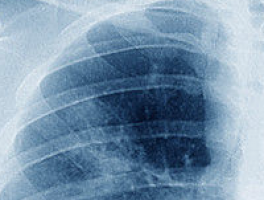
Findings from a recent study demonstrate that the PD-L1 inhibitor durvalumab demonstrated statistically significant and clinically meaningful improvement in overall survival (OS) compared with placebo for patients with Stage III, unresectable non-small cell lung cancer (NSCLC) who have not progressed following chemoradiotherapy (CRT).
Scott J. Antonia, M.D., Ph.D., department chair of the Thoracic Oncology Department at the H. Lee Moffitt Cancer Center and Research Institute in Tampa and professor of Oncologic Sciences at the University of South Florida College of Medicine, presented these findings today at the IASLC’s 19th World Conference on Lung Cancer (WCLC) in Toronto, Canada.
Results were published simultaneously in the New England Journal of Medicine.
Based on results from this trial, the European Commission has granted marketing authorisation for durvalumab as monotherapy for the treatment of locally-advanced, unresectable non-small cell lung cancer (NSCLC) in adults whose tumours express PD-L1 on ≥1% of tumour cells and whose disease has not progressed following platinum-based chemotherapy and radiation therapy (CRT).
Non-small cell lung cancer accounts for 85 percent of all newly diagnosed lung cancer cases.
The majority of patients are diagnosed with non-resectable disease, approximately 40 percent in advanced stages.
For patients who receive chemotherapy and concomitant radiotherapy there is a three-year survival rate of approximately 27 percent.[ii]
The PACIFIC trial was a randomised, double-blinded, placebo-controlled, multicenter trial of 713 patients in 235 study centers across 26 countries.
Of the 709 patients who received treatment, 473 received durvalumab and 236 placebo.
As of the data cutoff in March 2018, median follow-up duration was 25.2 months (range, 0.2 - 43.1).
After discontinuation, 41 percent and 54 percent in the durvalumab and placebo groups, respectively, received subsequent anticancer therapy; overall, 8.0 percent and 22.4 percent received another immunotherapy.
Results showed that durvalumab significantly improved OS, the second primary endpoint, versus placebo, with the median not reached and 28.7 months, respectively.
Durvalumab also improved OS in all pre-specified subgroups and improved secondary endpoints of time to death or distant metastasis (TTDM), time to second progression (PFS2), time to first subsequent therapy or death (TFST) and time to second subsequent therapy or death (TSST).
These results are significant because PACIFIC is the first trial to show a survival advantage following CRT in this patient population.
“Results of PACIFIC provide compelling evidence for the unprecedented benefit of durvalumab treatment as the standard of care in this patient population,” said Dr. Antonia. “Durvalumab offers the first major advance in this disease setting in many years, offering new hope to patients with Stage III, unresectable NSCLC without progression after CRT.”
Previously reported PACIFIC results showed that durvalumab significantly improved the first primary endpoint of progression free survival (PFS) versus placebo, and updated PFS remained similar, with medians of 17.2 and 5.6 months with durvalumab and placebo, respectively.
Durvalumab improved the updated TTDM, as well as PFS2, TFST and TSST.
Source: IASLC
We are an independent charity and are not backed by a large company or society. We raise every penny ourselves to improve the standards of cancer care through education. You can help us continue our work to address inequalities in cancer care by making a donation.
Any donation, however small, contributes directly towards the costs of creating and sharing free oncology education.
Together we can get better outcomes for patients by tackling global inequalities in access to the results of cancer research.
Thank you for your support.